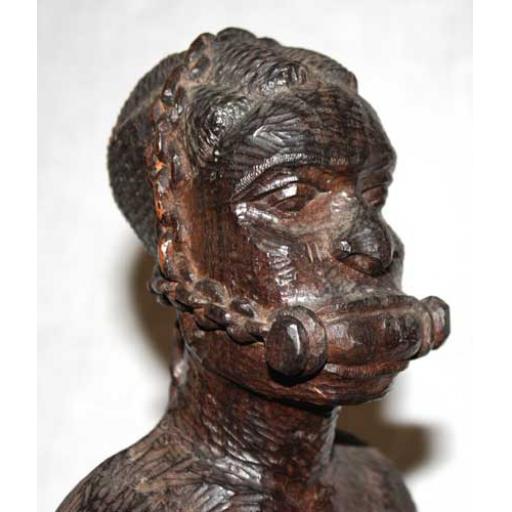History of Slavery in Africa
In the tapestry of human history, few chapters are as deeply etched and emotionally charged as the history of slavery in Africa. This narrative is a complex tapestry woven with threads of suffering, resilience, exploitation, and, ultimately, liberation. As we look into this gripping history, we'll traverse the ancient origins of African slavery, explore its enduring impact on the continent, and commemorate the indomitable spirit of those who fought for freedom.
The Beginnings of African Slavery
Slavery's haunting presence in northern Africa has roots dating back to ancient Egypt. The New Kingdom, spanning from 1558 to 1080 BC, witnessed the influx of large numbers of slaves, primarily prisoners of war, who were put to work in domestic and supervised roles along the Nile valley. Even during the Ptolemaic Egypt era, from 305 BC to 30 BC, both land and sea routes were employed to procure slaves.
Chattel slavery, a grim reality, persisted widely across North Africa. It found its place under the reign of Ancient Carthage, stretching from around 814 BC to 146 BC, and continued during the Roman Empire's rule (145 BC – ca. 430 AD) and the Eastern Romans (533 to 695 CE). Roman conquests in Africa resulted in the enslavement of defeated foes, with historical accounts like Orosius mentioning the enslavement of 27,000 North Africans by Rome in 256 BC.
Piracy emerged as a significant source of slaves for the Roman Empire, especially in the 5th century AD when pirates would raid coastal villages in North Africa, capturing their inhabitants. Even with the fall of the Roman Empire, chattel slavery endured in the predominantly Christian communities of the region.
As the Islamic trade expanded across the Sahara, these practices continued and gradually spread to major societies at the southern edge of the Sahara, including Mali, Songhai, and Ghana.
In medieval Europe, the slave trade primarily flowed eastward and southward. Both Christian and Jewish traders engaged in this trade. During the early medieval period, Jews played a significant role in the trade between Islamic and Christian regions, but by the 13th century, this dominance no longer applied to the slave trade.
The Mamluks, slave soldiers who had converted to Islam, became a powerful military caste during the Middle Ages. They served Muslim caliphs and Ayyubid Sultans, ultimately seizing power for themselves at times. For instance, they ruled Egypt from 1250 to 1517. Over time, white enslaved people from the Caucasus joined their ranks, forming an elite corps of troops.
According to Robert Davis, between the 16th and 19th centuries, Barbary pirates captured and enslaved an estimated 1 million to 1.25 million Europeans, selling them into slavery in North Africa and the Ottoman Empire. However, Davis's calculations are based on the assumption that the number of European slaves captured by Barbary pirates remained constant over a 250-year period, estimating that around 8,500 new slaves were needed annually to maintain their numbers.
This harrowing history of slavery in northern Africa leaves an indelible mark, a stark reminder of the suffering and brutality endured by countless individuals over the centuries.
The history of slavery in northern Africa is a dark and painful saga that spans millennia. From the ancient days of Egypt, where captives of war were forced into servitude, to the ruthless Roman Empire, which enslaved thousands in North Africa, the legacy of human bondage leaves a haunting imprint.
Even as empires rose and fell, the scourge of slavery persisted, driven by piracy and conquest. European captives were not spared as Barbary pirates swept down on coastal villages, taking men, women, and children into a life of unspeakable suffering.
In the heart of this tumultuous era, the Mamluks, once slaves themselves, became a formidable military force. Their journey from bondage to power is a testament to the enduring spirit of those who suffered under the yoke of servitude.
Yet, the emotional toll of slavery's brutality cannot be overstated. Families torn apart, lives forever scarred, and dreams shattered in the face of unimaginable cruelty. The legacy of this inhumanity persists, as the echoes of the past continue to reverberate in the present.
As we confront this somber chapter of history, we must remember and honor the resilience of those who endured. Their stories serve as a powerful reminder of the strength of the human spirit in the face of unimaginable adversity.




Indigenous Forms of Bondage
The specter of slavery has cast a long shadow over Africa's history. Throughout ancient times, systems of servitude and bondage were not unique to Africa; they were a haunting presence that afflicted much of the ancient world.
As history unfolded, the trans-Saharan slave trade, the Indian Ocean slave trade, and the notorious Atlantic slave trade, which began in the 16th century, converged upon Africa. These dark chapters in human history saw many of the pre-existing African systems of slavery supplying captives for distant and brutal slave markets beyond the continent's shores.
Even in contemporary Africa, the legacy of slavery persists, casting a haunting shadow over the present. It is a painful paradox that, despite being illegal, the practice endures in certain corners.
The scholarly discourse surrounding African slavery often distinguishes between two categories: indigenous slavery and export slavery. The distinction hinges on whether the enslaved individuals were traded beyond Africa's borders. This categorisation underscores the complexity of the historical African slave experience.
Slavery manifested in a myriad of forms in historical Africa. It encompassed debt slavery, the enslavement of war captives, the grim specter of military slavery, and the harrowing reality of individuals forced into prostitution. Even those who committed crimes found themselves ensnared in the web of slavery. This cruel institution infiltrated various corners of the continent.
Arab Slave Trade
The Arab slave trade, a haunting chapter in African history, spanned more than 13 agonising centuries. It emerged in the early seventh century and cast its dark shadow until the 1960s. The specter of slavery persisted in Mauritania until as recently as August 2007.
This grim history was marked by two main arteries of deportation. The first was the maritime route that linked the East African coast to the Middle East, while the second was the treacherous trans-Saharan caravan route.
In the East, the scourge of Arab raids haunted the Horn of Africa, East Africa, and the Great Lakes region. Captives from these brutal expeditions were ferried by sea from enclaves along the eastern coast, spanning from present-day Somalia to Mozambique, to the shores of the Red Sea and the Persian Gulf. Zanzibar served as a central hub for this inhuman trade.
In West Africa, the Arab slave trade engulfed a vast expanse, stretching from the Niger Valley to the Gulf of Guinea. This route followed the punishing trans-Saharan paths, where the journey could extend over three grueling months, characterized by a high mortality rate due to the dire conditions.
The words of the German explorer Gustav Nachtigal resonate with the horror of this journey: "The poor children of the black countries seem to meet death here, at the last stage of a long, hopeless and painful journey..." The journey under the merciless sun, hunger, thirst, and brutal exhaustion often culminated in abandonment and fading hope.
The Arab slave trade was stained with violence, castration, and sexual abuse. Men were systematically castrated to prevent reproduction, leading to a tragically high death rate—six out of ten did not survive this barbaric practice in castration centers. Women and girls also suffered as they were captured and subjected to sexual slavery.
Historians estimate that over 17 million people fell victim to the Arab slave trade. In the Saharan region alone, more than nine million African captives were torn from their homelands, with two million perishing along the cruel routes.
Tragically, this heinous phenomenon found sanction in Islam, echoing the later condoning of the transatlantic slave trade by Christianity. Despicable beliefs, like those of Tunisian Arab historian Ibn Khaldun, further dehumanized Africans. He wrote, "The only peoples to accept slavery are the Negroes, because of their lower degree of humanity..."
The Algerian Arab theologian Ahmed al-Wancharisi offered religious justifications, underscoring the moral darkness of the trade.
Once the captives reached their destinations, they were sold in slave markets across Cairo, Baghdad, Istanbul, Mecca, and other centers. Their lives were marked by servitude, labor, and, tragically, cannon fodder for wars.
The suffering occasionally ignited rebellion, such as the Zanj revolt near Basra in 869. Slaves from East Africa and the Great Lakes region, led by Ali Ibn Muhammad, rebelled, establishing their own state, only to be defeated in 883.
The Arab slave trade inflicted profound wounds on African societies, leaving some regions devastated and depopulated. The legacy of this trade also contributed to racialist theories that persist in some Arab countries, perpetuating stereotypes and discrimination.
The global remembrance of the transatlantic slave trade underscores the need for a similar acknowledgment of the victims of the Arab-Muslim slave trade. It's a call for international research, restoration of sites and monuments, educational initiatives, and cultural programs to shed light on this criminal activity. When will we see an International Day to commemorate these victims? When will their voices be heard, and their history be acknowledged? The time for justice and recognition is long overdue.
The Transatlantic Slave Trade
The transatlantic slave trade, a haunting segment of the global slave trade, stands as a chilling testament to the depths of human cruelty. It spanned three centuries, from the 16th to the 19th, during which an estimated 10 million to 12 million Africans were forcibly torn from their homes and transported across the vast and unforgiving Atlantic Ocean to the Americas.
This gruesome trade was the second leg of the infamous triangular trade, a web of commerce so heartless that it defies comprehension. Imagine a world where the commodities of choice were arms, textiles, and wine, and human lives were reduced to mere cargo. From Europe, these goods were shipped to Africa, where they served as the macabre currency for the lives of countless individuals.
Picture the harrowing scenes as ships laden with enslaved Africans departed from the shores of Africa, leaving behind a wake of broken families and shattered dreams. These were not willing passengers seeking a new life; they were human beings, stripped of their dignity, torn from their cultures, and thrust into a nightmare from which there seemed to be no escape.
The transatlantic slave trade was a journey through hell, where the wails of the oppressed echoed off the walls of the suffocating holds, and the stench of despair permeated the air. Families were torn apart, and individuals were subjected to unimaginable suffering, all in the name of profit.
But it was not just a trade in human lives; it was a trade in agony and inhumanity. Sugar and coffee, products of the Americas cultivated through the forced labor of enslaved Africans, were shipped back to Europe, completing the sinister triangle.
As we reflect on this dark chapter in human history, we cannot help but be overwhelmed by a profound sense of sorrow and outrage. The transatlantic slave trade was a grotesque manifestation of the darkest aspects of human nature, where greed and cruelty knew no bounds.
Yet, amidst this darkness, we also find stories of resilience and courage – stories of individuals who refused to be dehumanized, who clung to their humanity in the face of unspeakable brutality. These stories are a testament to the enduring strength of the human spirit and a reminder that even in the bleakest of times, there is hope for justice and redemption.




The Middle Passage
The Atlantic passage, known as the Middle Passage, was a nightmarish journey etched in the annals of human cruelty. It was a voyage that carried Africans, destined for Brazil or Caribbean islands, through a living hell. The brutality and inhumanity that unfolded on those wretched slave ships are almost beyond comprehension.
Imagine, if you can, the overcrowded, unsanitary conditions on these ships. Hundreds of Africans were crammed into tiers below decks, where they had to endure a voyage spanning about 5,000 miles, a voyage that could stretch from agonizingly long weeks to several unbearable months.
Chained together, they lay in the darkness, unable to sit upright due to the oppressively low ceilings. The heat inside was suffocating, and the air grew so thin that even candles refused to burn. The enslaved Africans were allowed on the upper decks for only a few hours each day, always under the watchful eyes of the crews who feared insurrection.
Historians' grim estimates reveal that between 15 and 25 percent of enslaved Africans bound for the Americas met their end aboard these floating hells. The death toll was directly proportional to the duration of the voyage, a grim statistic that fluctuated significantly between the early 16th century and the late 19th century.
The autobiographical account of Olaudah Equiano, a West African, published in 1789, stands as a chilling testament to the suffering endured on these transatlantic voyages. His words paint a vivid and haunting picture of the horrors that unfolded in the dark belly of those ships.
Atrocities and sexual abuse of the enslaved captives were widespread, a cruel and degrading reality that defies comprehension. Their monetary value as slaves perhaps mitigated such treatment, as their owners saw them as mere commodities. Ship captains, however, had a vested interest in the health of their human cargo, as they were paid only for enslaved persons delivered alive.
Yet, even among the crew members themselves, the toll of this inhumane trade was harrowing. Death rates among European captains and crew engaged in the trade were often as high as those among the enslaved Africans on the Middle Passage.
One infamous incident aboard the slave ship Zong in 1781 epitomizes the depths of depravity that the transatlantic slave trade sank to. Facing an infectious disease that claimed both Africans and crew members, Captain Luke Collingwood ordered more than 130 enslaved Africans to be thrown overboard in a desperate attempt to halt the contagion. He then cynically filed an insurance claim on the value of the murdered souls.
Occasionally, there were moments of defiance and resistance. The most famous of these incidents occurred in 1839 when a slave named Joseph Cinqué led a mutiny of 53 illegally purchased enslaved people on the Spanish slave ship Amistad. In a desperate bid for freedom, they killed the captain and two members of the crew. Their journey would ultimately lead them to the U.S. Supreme Court, which ordered their return to their homes, marking a rare victory for humanity in the face of unspeakable cruelty.
Resistance and Abolition
The period surrounding the American Revolution (1775–83) was marked by a growing sentiment in the Northern American colonies against the importation of more enslaved people. Many voices in the North spoke out against this morally abhorrent practice, recognizing the fundamental contradiction between the fight for liberty and the continuation of human bondage. However, the Southern states, heavily reliant on enslaved labor for their agrarian economy, insisted on maintaining this brutal trade.
In the aftermath of the Revolution, Congress succumbed to the pressure from the Southern states, delaying for more than two long decades before finally taking action to make the importation of enslaved people illegal. It was not until 1808 that this historic legislation was enacted, a law that was met with little dissent.
Yet, even with the law in place, the horrors of the transatlantic slave trade persisted. Caribbean smugglers frequently violated the law, evading justice and profiting from the misery of the enslaved.
Across the Atlantic, Great Britain took a significant step towards justice by outlawing slavery throughout its vast empire in 1833. The British navy, recognizing the profound evil of the trade in enslaved people, vigorously opposed it in the Atlantic. British ships patrolled the waters, seeking to prevent the abominable slave-trading operations that had claimed countless lives.
In Brazil, a nation heavily stained by the legacy of slavery, the trade of enslaved people was finally outlawed in 1850. However, the echoes of cruelty endured, as the smuggling of newly enslaved individuals into Brazil persisted. It was not until 1888 that Brazil finally enacted full emancipation, a delayed but crucial step towards recognizing the humanity and dignity of those who had suffered for so long.
These historical chapters serve as poignant reminders of the complex and deeply rooted struggle for justice and freedom. They reflect the moral awakening of societies, often hindered by vested interests, and the tireless efforts of individuals and movements that championed the cause of humanity. The fight against the transatlantic slave trade was a protracted and painful one, marked by both victories and setbacks, but it ultimately stands as a testament to the enduring power of the human spirit to seek justice and redemption, no matter how long the road to liberation may be.




Revolts and Uprisings
Slave rebellions represent a haunting and heroic chapter in the history of the Americas, where those held in brutal bondage rose up against their oppressors in acts of profound courage. These periodic acts of violent resistance by Black slaves spanned nearly three centuries during the era of chattel slavery, and they bore witness to a deep-rooted discontent with the horrors of their condition.
In the United States, the myth of the contented slave was a cruel falsehood that was perpetuated to justify the South's "peculiar institution" of slavery. The historical record of these rebellions was often shrouded in exaggeration, censorship, and distortion. Yet, despite efforts to suppress the truth, the resilience of enslaved individuals persisted, and their determination to break free from the chains of oppression ignited sparks of hope.
Estimates of the total number of slave revolts vary, depending on how one defines insurrection. Over the two centuries leading up to the American Civil War (1861–65), more than 250 uprisings or attempted uprisings involving groups of 10 or more slaves striving for personal freedom have been documented. These revolts were not always grand and meticulously planned events; many were spontaneous, short-lived disturbances initiated by small groups of enslaved people.
These rebellions were often led by male bondsmen who dared to dream of liberation, but they were also frequently betrayed by house servants who felt a closer connection to their masters. The goals of these uprisings varied; some sought complete freedom, while others aimed for more modest improvements in their conditions or the ability to work part-time for themselves and their families.
Several slave rebellions deserve special recognition for their enduring impact on the struggle for freedom. In the European colonies of the Caribbean and Latin America, some of the earliest episodes unfolded. In 1570, at a sugar plantation in Veracruz, Gaspar Yanga emerged as a legendary figure by leading his fellow slaves into the nearby mountains, where they lived for nearly four decades. Armed and supplied through raids on Spanish colonists, they waged guerrilla warfare against their oppressors.
Despite the formidable power of the Spanish colonial authorities, they could not extinguish the flame of freedom that burned within Yanga and his followers. In 1609, after years of resistance, a treaty was finally negotiated, granting the former slaves their liberty and the right to establish their own free settlement. This historic moment led to the founding of San Lorenzo de Los Negros, known today as Yanga, the first settlement of freed African slaves in North America.
The legacy of these brave souls endures as a testament to the unyielding human spirit and the enduring quest for freedom and dignity. Their stories remind us that even in the darkest of times, the flame of hope and the call for justice can never be extinguished.
The Abolitionist Movement
The abolition movement, a beacon of hope and humanity, emerged as a powerful force in the late 18th century, marking a profound shift in the moral consciousness of society. Rationalist thinkers of the Enlightenment, guided by the principles of reason and the "rights of man," were among the first to vehemently criticize the abhorrent institution of slavery. They saw it as a gross violation of the fundamental principles of human rights and dignity.
Religious groups, particularly Quakers and evangelicals, also rose in opposition to slavery. Their faith led them to condemn it for its blatant disregard of Christian values and its dehumanizing effects on both enslaved individuals and those who perpetuated the system.
By the late 18th century, moral disapproval of slavery had spread like wildfire, igniting the hearts of countless individuals who could no longer turn a blind eye to the suffering it caused. Antislavery reformers achieved some seemingly easy victories during this period, marking the beginning of a movement that would change the course of history.
In Britain, the pivotal legal decision secured by Granville Sharp in 1772 declared that West Indian planters could not hold slaves in Britain because slavery contradicted English law. In the United States, all states north of Maryland took a momentous step by abolishing slavery between 1777 and 1804.
However, these early successes had limited impact on the heartlands of slavery—the vast plantations of the Deep South, the West Indies, and South America, where the cruel institution remained deeply entrenched.
Undeterred by the formidable challenges, British and American abolitionists turned their attention to these regions, determined to put an end to the importation of enslaved Africans into the British colonies and the United States. Visionary leaders like William Wilberforce and Thomas Clarkson led the charge in the late 18th century, channeling their passion into a movement that would change the course of history.
Their tireless efforts paid off when the slave trade to the British colonies was abolished in 1807, followed by the United States' prohibition of slave importation that same year. Yet, the battle was far from over, as widespread smuggling persisted for decades.
The focus then shifted to securing the emancipation of those already held in bondage. Triumph came when slavery was abolished in the British West Indies by 1838 and in French possessions a decade later.
The abolition movement, driven by the unshakeable belief in the intrinsic worth and dignity of every human being, transformed the emotional climate of an era. It created a groundswell of empathy and a collective determination to put an end to the transatlantic slave trade and the cruel system of chattel slavery. It was a movement rooted in the very essence of humanity—compassion, justice, and the unyielding spirit of those who dared to dream of a world free from the chains of oppression.
Impact on Modern Africa
Disruption of Societies: African slavery tore apart communities and disrupted traditional societies. Families were torn asunder, and entire communities were uprooted. This fragmentation of African societies left scars that still resonate today, as many struggle to piece together their cultural heritage and ancestral connections.
Economic Consequences: The loss of millions of able-bodied men and women to the transatlantic slave trade had devastating economic consequences for Africa. It left a labor shortage that hindered economic development and set the stage for later exploitation by colonial powers.
Cultural and Spiritual Trauma: The trauma of slavery runs deep in the collective consciousness of Africans. The forced separation from their ancestral lands, languages, and traditions left a profound cultural void. Many Africans today grapple with the challenge of reclaiming and preserving their cultural heritage.
Legacy of Injustice: The legacy of slavery also includes the enduring injustices that persist today. Discrimination, inequality, and systemic racism continue to plague African societies. These issues are a painful reminder of the historical injustices that have yet to be fully reckoned with.
Diaspora and Identity: The African diaspora, born out of slavery, has created a global African identity that transcends borders. The African diaspora has contributed to diverse cultures and societies worldwide, enriching the global tapestry of human civilization.
Resilience and Cultural Revival: Despite the profound challenges, modern Africa is marked by resilience. African nations have made significant strides in rebuilding their societies, preserving their cultures, and asserting their identities on the global stage.
Struggles for Justice: The legacy of African slavery has fueled movements for justice, reparations, and acknowledgment of the historical wrongs inflicted upon the continent. These movements continue to gain momentum and seek redress for past atrocities.
In the emotional tapestry of modern Africa, the history of slavery is a thread that cannot be undone. It is a story of suffering and survival, of cultural loss and resilience, and of a determination to forge a brighter future. The impact of African slavery reverberates through time, reminding us of the enduring strength of the human spirit and the ongoing quest for justice and healing.
Healing and Reconciliation
Healing and Reconciliation: The scars of slavery run deep, and the process of healing and reconciliation is a journey fraught with emotion and complexity. It is a journey that individuals, communities, and nations across Africa and the diaspora are undertaking with unwavering determination.
Acknowledgment of Pain: Healing begins with acknowledgment. It is an acknowledgment of the immense pain and suffering endured by generations of Africans. It is an acknowledgment that the wounds of the past have not fully healed, and that the legacy of slavery still lingers in the hearts and minds of people.
Truth and Reconciliation: Truth-telling is a crucial step in the process. It involves confronting the painful truths of the past—acts of brutality, exploitation, and dehumanization. Truth-telling is not easy; it requires courage to face the darkest chapters of history. Yet, it is an essential part of the healing process.
Restoration of Identity: Slavery robbed millions of Africans of their identities, languages, and cultures. Healing involves a profound effort to restore and celebrate these aspects of identity. It is a reclaiming of heritage and a reaffirmation of pride in African roots.
Empowerment and Justice: Healing is not passive; it is an act of empowerment. It involves seeking justice for the descendants of those who suffered. It is a call for reparations, for policies that address systemic inequalities, and for the dismantling of structures that perpetuate discrimination.
Rebuilding Communities: Healing extends to the rebuilding of communities torn apart by slavery. It is a process of reconnection, of reestablishing bonds, and of forging a collective identity that transcends the painful divisions of the past.
Unity in Diversity: Reconciliation is about finding unity in diversity. It is an acknowledgment that the African diaspora is a tapestry woven from diverse threads—different cultures, languages, and experiences. It is a celebration of this diversity and an understanding that unity can be found in shared history and shared aspirations.
Education and Awareness: Healing also involves education and awareness. It is about ensuring that future generations are not only aware of the history of slavery but also understand its profound impact. It is through education that the cycle of ignorance and prejudice can be broken.
Embracing Hope: Healing and reconciliation are not quick fixes; they are processes that take time. But they are processes infused with hope—a hope for a future where the wounds of slavery are no longer an open sore. It is a hope for a world where the legacy of slavery is transformed into a testament of resilience and the enduring power of the human spirit.
In the emotional landscape of healing and reconciliation, there are moments of pain and anguish, but there are also moments of triumph and renewal. It is a journey marked by the collective determination of people to confront the past, seek justice, and build a future where the echoes of slavery are drowned out by the harmonious voices of unity and healing.
FAQs
How were slaves kept under control?
A variety of methods were employed to maintain control over enslaved individuals. Leg and hand restraints, such as iron bars and shackles, were utilized to prevent escape. Additionally, an iron ring was often fastened around the neck as a means of restraint. During transportation, slaves were interconnected through chains, further restricting their movement. The acquisition of slaves was facilitated through the exchange of currency known as manillas or cowrie shells.
What were the main causes of African slavery?
African slavery had diverse causes, including economic exploitation, social hierarchies, and the demand for labor in various industries.
How did the transatlantic slave trade impact African cultures?
The transatlantic slave trade resulted in the disruption and loss of cultural practices and traditions in Africa, as well as the forced dispersal of African people to different parts of the world.
Were there any successful slave revolts in Africa?
Yes, there were several successful slave revolts in Africa, such as the Haitian Revolution, which led to the establishment of the first black republic in the Americas.
What is the current status of slavery in Africa?
While slavery as a formal institution has been abolished in most African countries, contemporary forms of exploitation and human trafficking persist in some regions.
How can we commemorate the legacy of African slavery today?
We can commemorate the legacy of African slavery by acknowledging its historical significance, promoting education and awareness, and actively working towards social justice and equality for all.





















